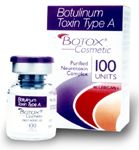- Acne
- Actinic Keratosis
- Aesthetics
- Alopecia
- Atopic Dermatitis
- Buy-and-Bill
- COVID-19
- Case-Based Roundtable
- Chronic Hand Eczema
- Chronic Spontaneous Urticaria
- Drug Watch
- Eczema
- General Dermatology
- Hidradenitis Suppurativa
- Melasma
- NP and PA
- Pediatric Dermatology
- Pigmentary Disorders
- Practice Management
- Precision Medicine and Biologics
- Prurigo Nodularis
- Psoriasis
- Psoriatic Arthritis
- Rare Disease
- Rosacea
- Skin Cancer
- Vitiligo
- Wound Care
Article
Botulinum toxin long-term safety study finds 'no news is good news'
New York - Results of a retrospective review reinforce the long-term safety and tolerability of repeated treatments with botulinum toxin type A (Botox Cosmetic?, Allergan) for cosmetic reasons, said Alastair Carruthers, M.D., at the American Academy of Dermatology's Academy '04 here recently.
New York - Results of a retrospective review reinforce the long-term safety and tolerability of repeated treatments with botulinum toxin type A (Botox Cosmetic®, Allergan) for cosmetic reasons, said Alastair Carruthers, M.D., at the American Academy of Dermatology's Academy '04 here recently.
The study The study encompassed 50 patients who underwent 853 treatment sessions. To be included in the study, subjects had to have received a minimum of 10 injections with the first treatment given before January, 1999. The median number of treatments received per patient was 19 and the median interval from first to last treatment approached six years.

"From the results of this study, it seems we can conclude that no news is good news, and that potential candidates and practitioners alike can be reassured about the safety of appropriately administered botulinum toxin injection for cosmetic purposes," says Dr. Carruthers, clinical professor of dermatology, University of British Columbia, Vancouver.
Thanks to the remarkably favorable risk:benefit profile it demonstrated in clinical trials, botulinum toxin injection rapidly gained popularity after its marketing approval to become the most common cosmetic procedure performed in the United States. However, while its use was becoming more widespread, concerns were beginning to emerge about the safety of multiple treatments.
Suitable database As the innovators of botulinum toxin treatment for cosmetic reasons, Dr. Carruthers and his wife Jean D. Carruthers, M.D., clinical professor of ophthalmology , University of British Columbia, had the necessary experience to address that issue.
Funding for their retrospective trial was provided by an unrestricted grant from Allergan, Inc., and they hired a private clinical research organization to identify and contact study subjects, extract and collect data and perform the analyses.
"In so far as was possible, we felt the methods used for this investigation allowed for a reasonably independent assessment of the long-term safety of botulinum toxin," Dr. Carruthers says.
Patients selected for inclusion in the analyses had to have been treated for facial rhytids and be Ž18 years of age. Individuals who met the eligibility criteria based on chart review were contacted to obtain informed consent.
The 50 patients ranged in age from 27 to 69 years, had a mean age of 43 years, and were predominantly women (92 percent), and white (92 percent). Their medical histories were unremarkable. About two-thirds of the subjects received treatments in three or more anatomic areas; glabellar rhytids (49 patients), crow's feet (35 patients) and forehead rhytids (32 patients) were the most common treatment sites.
Dose, dosing interval not predictors The number of botulinum toxin injections administered per patient ranged up to 30 and the cumulative dose range was between 244 and 1,603 units (median 690). The dose per session ranged from two to 110 units (median 40). The mean dose of botulinum toxin for sessions associated with an adverse event was about 67 units.
The shortest total period of treatment in the study was 2.82 years while the longest was almost nine years, although Dr. Carruthers observes some of the subjects had really been treated over an even longer interval considering there was limited recordkeeping in the earliest patients.
Statistical testing showed no relationship between the interval between treatment sessions or the number of treatments and the risk of adverse events.
Newsletter
Like what you’re reading? Subscribe to Dermatology Times for weekly updates on therapies, innovations, and real-world practice tips.











